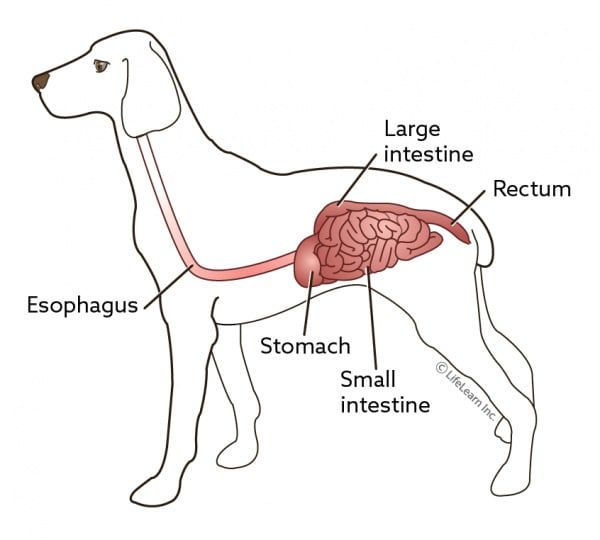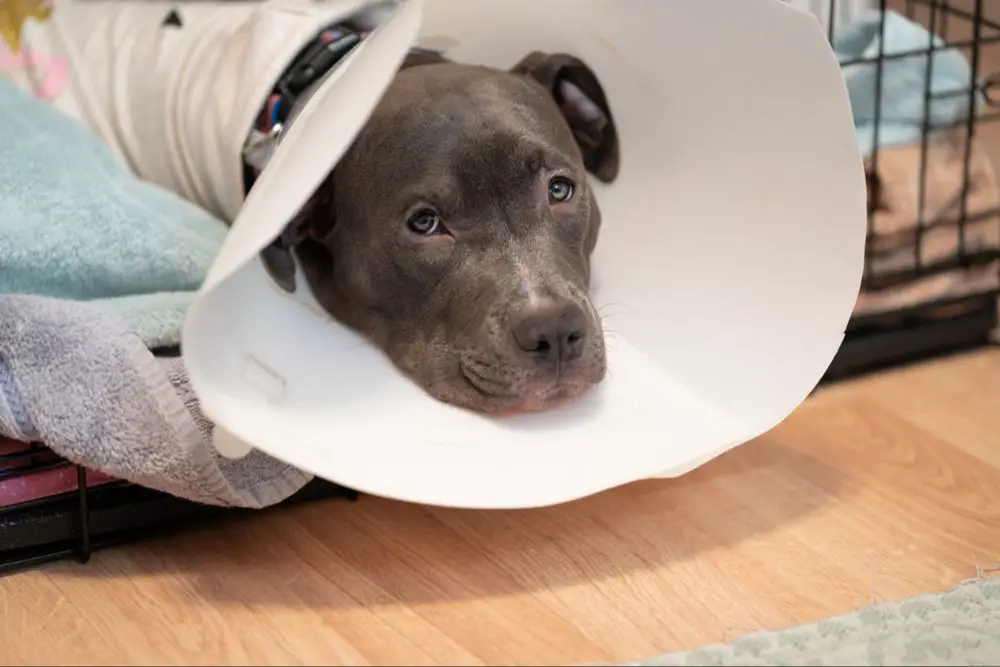Introduction
It’s normal for dogs to experience some pain and discomfort after undergoing spay surgery. Spaying, also known as an ovariohysterectomy, involves removing a female dog’s reproductive organs – the ovaries and uterus. This is a major abdominal surgery, so it’s understandable that dogs may not feel 100% back to normal right away during the recovery period.
One common concern dog owners notice is that their dog seems to cry or whine when pooping after a spay. There are a few reasons this may happen:
What Happens During Spay Surgery
During a spay surgery, the veterinarian will make an incision just below the dog’s belly button to gain access to the uterus and ovaries, which are located in the abdomen. The vet will then find each ovary and uterine horn and tie them off before removing them completely. The uterus is detached from the cervix and also taken out. Spaying in Dogs – VCA Animal Hospitals says the surgery usually takes 30 to 60 minutes, depending on the dog’s size and age.
Once the ovaries and uterus are removed, the vet will close the incision with stitches or surgical glue. The dog is monitored during recovery from anesthesia and may need pain medication before going home. The spay surgery removes the source of heat cycles and the ability to reproduce. Ask a Vet: All You Need to Know About Spay/Neuter Surgery from the MSPCA says the surgery is a safe, routine procedure when performed by an experienced veterinarian using proper surgical techniques.
Why Do Dogs Cry When Pooping After Spay Surgery?
There are a few main reasons why dogs may cry or yelp when trying to poop after getting spayed:
Surgical Pain – The incision site from the spay surgery may still be quite tender and sensitive in the days following the procedure. The act of pooping causes pressure and movement in the abdomen, which can pull on the stitches and cause pain. This is especially true if the dog is straining or having difficulty passing stool (more on this below).
Difficulty Pooping – Some dogs have trouble pooping normally after surgery due to factors like anesthesia side effects, change in diet, stress, or simply not wanting to push because of discomfort. Straining or passing hard, constipated stool can certainly hurt and cause a dog to vocalize.
Vulnerability – When pooping, dogs are in a vulnerable position with their bottoms exposed. After surgery, this feeling of vulnerability may be heightened. The crying could simply be the dog feeling anxious about pooping after surgery.
The bottom line is that spay surgery causes significant pain and inflammation internally. Any bodily process that puts pressure on the abdomen, like pooping, can exacerbate pain and cause a dog to cry, whine, or yelp. It’s a natural response resulting from post-surgical discomfort.
Surgical Pain
Spay surgery involves making an incision in the dog’s abdomen to remove the ovaries and often the uterus. This invasive procedure can cause both external and internal pain while the incision site and internal tissues heal.
The external incision causes localized pain and discomfort. The incision is closed with stitches or staples, which can cause irritation as the skin mends back together. There may also be bruising and inflammation around the incision. Dogs usually want to lick or nibble at the incision site, which should be discouraged so as not to disturb the healing. Wearing an Elizabethan collar prevents this behavior.
Internally, the areas where the ovaries and uterus were removed go through an initial healing process which involves inflammation. The internal tissues heal back together, which takes several weeks. During this time there can be mild to moderate internal pain. Internal pain may worsen when having a bowel movement.

Most vets prescribe pain medication for 3-7 days after spay surgery to manage both the external and internal surgical pain. Common medications prescribed include Torbugesic, Rimadyl, or non-steroidal anti-inflammatory drugs like Metacam. These help provide pain relief as the surgical site heals. Signs of continuing pain beyond the initial week may warrant an extension of pain medication.
Difficulty Pooping
Constipation is very common after spay surgery in dogs. The anesthesia and pain medication given during and after surgery can slow down the gastrointestinal tract, making it difficult for dogs to have normal bowel movements.
Dogs may strain, whimper, or cry when trying to poop after their spay due to constipation from the anesthesia. The abdominal incision can also cause pain when pooping after surgery.
According to the MedVet, it’s very common for animals not to have a bowel movement for 1-3 days after surgery.
The Healing Heart Veterinary Care also notes that difficulty pooping is expected after anesthesia and surgery, and it can take a few days for normal bowel function to return.
While concerning, this is usually temporary as the medication wears off over a few days after the spay procedure. Giving stool softeners can help make pooping less painful until bowel movements return to normal.

Vulnerability
Dogs may cry when pooping after a spay surgery because they feel exposed and vulnerable. The surgery site is still healing, so dogs instinctively want to protect themselves during this vulnerable process. Pooping requires assuming a crouched position with the hindquarters exposed. This goes against a dog’s natural instinct to protect themselves when injured. The crying could simply be communicating sadness, frustration, or discomfort over feeling exposed and unable to prevent it.
According to the SPCA, it’s normal for dogs to be weak, depressed or show changes in behavior in the days following a spay surgery (https://spca.org/resources/clinic/spay-neuter/care-after-spay-neuter-surgery/). These behavioral changes are likely due to the anesthesia and pain medications wearing off, but may also indicate the dog is feeling vulnerable. Being patient and providing extra comfort during this time can help ease a dog’s distress.
How to Help Your Dog
There are a few things you can do to help your dog feel more comfortable when pooping after their spay surgery:
Pain Management – Be sure to give your dog any prescribed pain medication as directed by your vet. This will help manage discomfort during bowel movements. You can also try giving over-the-counter dog-safe pain relievers like acetaminophen or ibuprofen, but only under the guidance of your vet (1).
Laxatives – If your dog is constipated or having difficulty pooping, ask your vet if you can give a mild laxative or stool softener. This can make passing stools less painful and straining less likely after surgery (2).
Remain Calm – Your energy and demeanor can impact your dog’s emotions. Stay relaxed and soothing when taking your dog outside to poop. This will help keep your dog calm as well (3).

Speak to your vet if your dog continues having issues with painful pooping after their spay surgery. They can recommend additional medications or therapies to aid your dog’s recovery.
When to Call the Vet
Most dogs will recover well after being spayed, but some complications can occur that require veterinary attention. It’s important to monitor your dog closely after surgery and contact your veterinarian if you notice any of the following prolonged issues with pooping or signs of infection:
- Difficulty pooping or straining to poop beyond 2-3 days after surgery
- Still crying or whining when trying to poop more than 3 days after surgery
- Not pooping at all within 24 hours after surgery
- Excessive swelling, redness, pain, or discharge around the incision site
- Fever over 102°F
- Loss of appetite beyond the first day after surgery
- Lethargy, vomiting, or diarrhea
If your dog shows any of these signs, contact your veterinarian right away. Prolonged issues with pooping or an infection at the incision site both require prompt veterinary attention and treatment with medication or possibly additional surgery. Don’t wait to see if the symptoms resolve on their own, as delays could lead to greater complications. It’s always better to be safe and have your vet examine your dog if anything seems abnormal during the recovery period.
Recovery Timeline
The recovery timeline for dogs after a spay surgery can vary, but there are some common milestones. According to PetMD, dogs need to restrict their activity for at least 10-14 days after the surgery to allow proper healing1. During this initial recovery period, it is common for dogs to experience some pain or discomfort when going to the bathroom, which can cause crying or vocalizations.

For the first few days after surgery, the incision area may be swollen and dogs may have difficulty pooping comfortably. The crying when pooping is likely due to surgical pain and tenderness around the incision site. This discomfort when pooping and associated vocalizations can last up to 2 weeks as the incision fully heals according to Zoetis Petcare2. However, the pain and difficulty should decrease gradually over time.
It’s important to monitor the dog closely and provide support, like soft bedding, during these initial weeks after surgery. If the crying persists beyond 2 weeks or seems to get worse, veterinary attention may be needed.
Summary
In summary, dogs often cry when pooping after spay surgery due to pain or difficulty passing stool. This is normal in the first days after surgery as the incision site heals. Try to make your dog as comfortable as possible by keeping her confined, taking short gentle walks, feeding a bland diet, and administering any prescribed pain medication. Monitor your dog’s symptoms and call your vet if crying persists more than a few days, there’s no bowel movement, vomiting/diarrhea occurs, or you notice signs of infection. With rest and care, your dog should recover within 1-2 weeks. The spay surgery protects your dog’s health in the long run by preventing unwanted litters and reducing cancer risk. If crying during bowel movements continues beyond the expected recovery timeline, consult your vet to rule out complications. With patience and a watchful eye during recovery, your beloved dog will be back to her happy, healthy self in no time.